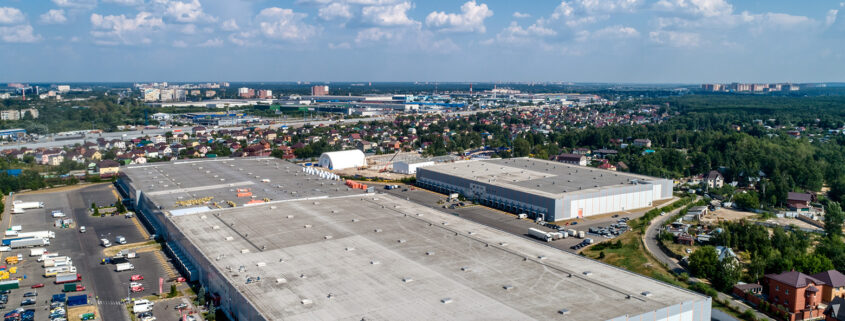So it’s time to start thinking about a new roof for your commercial building. The good news is there are options, and the expert roofers at TEMA Roofing Services can help you find the best fit by looking at different commercial flat roof materials. Different commercial roofing systems have sets of benefits ranging from energy efficiency to lifespan.
Let’s take a look at commercial roofing materials and characteristics to help you decide the type of roof you should have installed.
Single-Ply Membrane Roofs
Single-ply roofing is made up of rubber and other synthetic sheet materials. The installation process of a new roof onto flat or low slope roofs either uses an adhesive or the membranes are ballasted (attached) with gravel. The lifespan is decades for single-ply membrane roofs. Let’s get into the list of commercial flat roofing systems and materials.
PVC, TPO, and EPDM are popular commercial roof types. They’re known for their energy efficiency, being cost-effective, and having a lifespan of about 30 years.
PVC Roofing
Polyvinyl chloride (PVC) is a very durable type of plastic. It’s heat-welded, so there are fewer seams than in other types of commercial flat roofing. PVC is “attached” by adhesive or solvent welding. Reflective components in PVC help to protect it from UV rays, lowering energy bills. It’s also watertight and fire-resistant.
TPO
Thermoplastic polyolefin (TPO) is a recycled rubber roofing and a relative newcomer in the commercial flat roofing industry. It’s similar to PVC in terms of affordability, reflection abilities, heat and water resistance, and nearly a three-decade lifespan. TPO roofing is not ballasted.
EPDM Roofing Materials
Another rubber roof membrane, ethylene propylene diene monomer, is a synthetic rubber that has been used since the 1960s and is extremely popular. The sheets of EPDM are attached with seam tape. EPDM is usually dark in color and absorbs sunlight, cutting down on energy bills. It’s easier to repair and has low maintenance.
Some Cons Of Purchasing Single-Ply Roofing
While there are many positive benefits to single-ply membrane roofing, there are a few things to consider before building owners choose single-ply for their new roof. There’s no hard protective layer, so they are easily punctured. Some membranes can shrink or become brittle over time, too.
Built-Up Roof Systems
Another commercial flat roof option is the built-up roof system, also called a BUR. In a BUR, layers of asphalt and ply sheets, or felts, are applied over a roof deck. Insulation is usually the bottom layer, which is attached to the roof deck.
The layered approach provides waterproofing and UV-ray protection. Low maintenance and easy roof repair lead to a low cost over its lifespan of about 30 years.
Modified Bitumen Roof
Also known as atactic polypropylene, Modified Bitumen Roofing is a family member of Built-Up Roofing used on low-slope roofing. It’s created from a combination of polymers, fillers, and asphalt. The components help make this type of commercial roofing practically waterproof.
There are two types of Modified Bitumen Roofing.
APP
APP is atactic polypropylene, referred to as plastic asphalt. It’s applied in a torch-down method – using a torch – and acts similar to hot mopping asphalt.
SBS
This is styrene-butadiene-styrene or synthetic rubber. When heated, SBS is sticky and takes a while to heat to a workable temperature.
Cons Of A Built-Up Roof
There are some cons to Built-Up Roofing. Because there are more layers to install, labor costs can add up. Windy weather conditions can peel off layers of the roofing system, or rocks from ballasted Built-up Roofing can get knocked loose causing damage to other nearby structures. The weight of the roof is heavier than single-ply, meaning buildings need to be strong enough to support the additional weight of the Built-Up Roofing.
What’s Needed For A Metal Roof?
An aesthetically pleasing roofing choice is metal. Fire resistance, sustainability, and little maintenance help metal commercial flat roofing last upwards of 60 years. A metal roof has a very slight slope and is common to be seen on top of manufacturing or warehouse buildings. Metal roofing systems are constructed to prevent water from leaking through. Metal roofing can be made of recycled metals and can handle severe weather conditions.
Things To Consider Before Installing A Metal Roof
Metal roofing systems do have some things to think about before purchasing and installing. They can be expensive and tend to fluctuate with temperature. They are also noisy with heavy foot traffic and can easily dent or corrode over time.
Schedule Our Commercial Roofing Contractors
Now you know a little more about commercial flat roof materials and flat roofing systems. TEMA Roofing Services is your commercial roofing solution expert. Contact us today to find out more about any warranty options and to schedule your roof installation or roof replacement.





